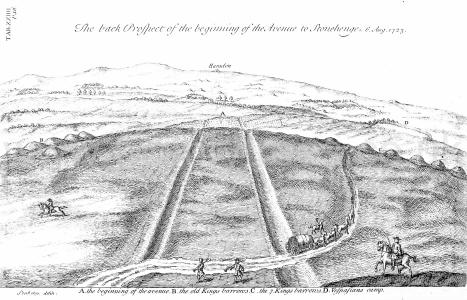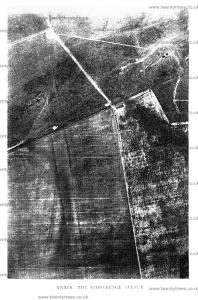Europe, British Isles, South-West England, Wiltshire, Stonehenge Landscape, Stonehenge Monuments and Burials, Stonehenge Avenue [Map]
Stonehenge Avenue is in Stonehenge Monuments and Burials, South England Avenues, Stonehenge Late Neolithic Early Bronze Age.
2400BC. The Stonehenge Avenue [Map] is a 2.8km Avenue of two parallel ditches, about 20m apart, with banks on both sides that connects Stonehenge to the Wiltshire River Avon. It is neither straight or level. It descends from Stonehenge oriented to the angle of the Midsummer sunrise then turns towards the east continuing upslope after which it turns to the south east and descends to the Wiltshire River Avon. At the Stonehenge end there is a natural feature of chalk ridges whose orientation is on the midsummer sunrise / midwinter sunset which some believe may have been significant in the siting the monument.
Carbon Date. 1720BC. Middle Bronze Age Carbon Dates
Report: antler; from near the base of the ditch.
ID: 17862, C14 ID: HAR 2013 Date BP: 3720 +/- 70, Start Date BP: 3790, End BP: 3650
Abstract: Stonehenge: Avenue [Map]; 1976-77
Reference Name: Jordan, D, Haddon-Reece, D, Bayliss, A 1994 'Radiocarbon dates: from samples funded by English Heritage and dated before 1981', London: English Heritage
Council for British Archaeology (2012) Archaeological Site Index to Radiocarbon Dates from Great Britain and Ireland [data-set]. York: Archaeology Data Service [distributor] https://doi.org/10.5284/1017767
Carbon Date. 1678BC. Middle Bronze Age Carbon Dates
Report: Antler, from context C6, Avenue northern ditch [Map], Stonehenge terminal (C6) in primary silt, Phase 3 at Stonehenge, Wiltshire, England. Comment (subm): Date accepted as reliable; 2 sigma cal range given.
ID: 8078, C14 ID: BM-1164 Date BP: 3678 +/- 68, Start Date BP: 3610, End BP: 3746
OS Letter: SU, OS East: 123, OS North: 422
Archaeologist Name: (ed Cleal)
Reference Name: Cleal, R M J et al, 'Stonehenge in its landscape: 20th century excavations' (Engl Heritage Archaeol Rep, 10, 1995), 319, 323, ??? 2, Table 64
Council for British Archaeology (2012) Archaeological Site Index to Radiocarbon Dates from Great Britain and Ireland [data-set]. York: Archaeology Data Service [distributor] https://doi.org/10.5284/1017767
Carbon Date. 1400BC. Late Bronze Age Carbon Dates
Report: Charcoal from hearth in Stone Floor (Late Neo assemblage 12m from Avenue ditch) at Stonehenge Avenue [Map], Wiltshire, England. Comment (lab): Preliminary (micro counter) result
ID: 8930, C14 ID: HAR-4878 Date BP: 3400 +/- 150, Start Date BP: 3250, End BP: 3550
OS Letter: ST, OS East: 122, OS North: 422
Archaeologist Name: M W Pitts
Reference Name: Proc Prehist Soc, 48, 1982, 75-132 esp 128 (date)
Council for British Archaeology (2012) Archaeological Site Index to Radiocarbon Dates from Great Britain and Ireland [data-set]. York: Archaeology Data Service [distributor] https://doi.org/10.5284/1017767
Carbon Date. 1020BC. Late Bronze Age Carbon Dates
Report: Antler from NE ditch just N of West Amesbury House (= Pd IV) at Stonehenge Avenue [Map], Wiltshire, England.
ID: 4503, C14 ID: BM-1079 Date BP: 3020 +/- 180, Start Date BP: 2840, End BP: 3200
OS Letter: SU, OS East: 141, OS North: 415
Archaeologist Name: I F Smith
Reference Name: Radiocarbon, 21, 1979, 341-2; Roy Comm Hist Monuments (England), 'Stonehenge and its Environs' (1979), 8 and 11; Proc Prehist Soc, 48, 1982, 75-132
Council for British Archaeology (2012) Archaeological Site Index to Radiocarbon Dates from Great Britain and Ireland [data-set]. York: Archaeology Data Service [distributor] https://doi.org/10.5284/1017767
Carbon Date. 750BC. Early Iron Age Carbon Dates
Report: Antler and bone, id as antler tine and two bovine scapulae, from primary chalk silt of both ditches (below Amesbury bypass) at Stonehenge Avenue [Map], Wiltshire, England.
ID: 4612, C14 ID: I-3216 Date BP: 2750 +/- 100, Start Date BP: 2650, End BP: 2850
OS Letter: SU, OS East: 123, OS North: 422
Archaeologist Name: L and F Vatcher (Hawley 1923)
Reference Name: Radiocarbon, 21, 1979, 341-2; Antiquity, 50, 1976, 239-40; R M Cleal et al, 'Stonehenge in its landscape' (1995) (rephasing)
Council for British Archaeology (2012) Archaeological Site Index to Radiocarbon Dates from Great Britain and Ireland [data-set]. York: Archaeology Data Service [distributor] https://doi.org/10.5284/1017767
Stonehenge by William Stukeley. Table XXIV. The back Prospect of the beginning of the Avenue [Map] to Stonehenge. A. the beginnings of the avenue. B. the old Kings barrows C. the 7 Kings barrows D. Vespasian's Camp [Map]. [Haradon Hill is speculatively identified as what is now known as Telegraph Hill [Map]] on which there are numerous tumuli.

Wessex from the Air Plates 39 and 40. The Stonehenge Avenue [Map].
